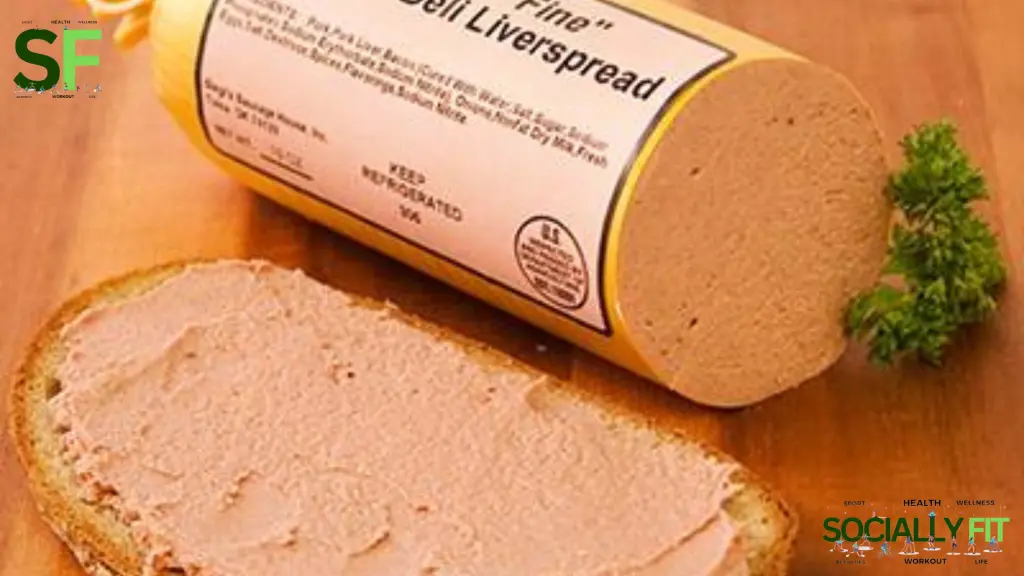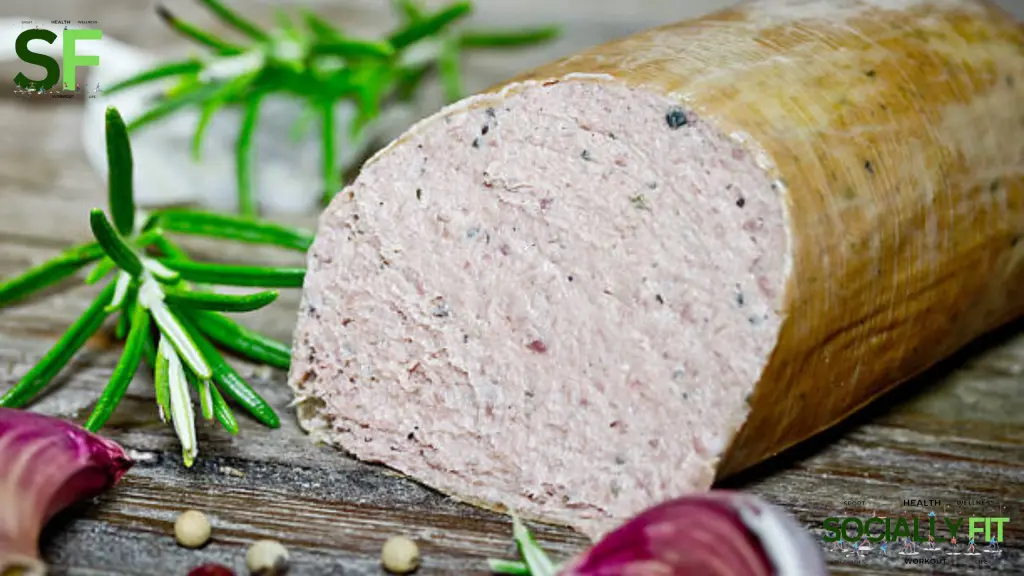Is Liverwurst Healthy? Discover if liverwurst is a healthy choice. Learn about its nutritional profile, health benefits, potential risks, and how to include it in a balanced diet while managing fats and sodium.
Introduction

Liverwurst is a type of sausage made primarily from liver and other meat cuts. While it’s popular in many European countries and sometimes used as a sandwich spread, many wonder if it’s a healthy food choice. Is liverwurst a nutrient powerhouse, or does its potential downsides outweigh the benefits? In this article, we’ll take an in-depth look at liverwurst to answer these questions.
Is Liverwurst Healthy
What Is Liverwurst?
Liverwurst, also known as liver sausage, is typically made from pork or beef liver mixed with other meat cuts, fats, and spices. Depending on the recipe, some varieties may also include additional ingredients like onions, herbs, or even bacon. It’s available in both smooth, spreadable forms and firmer, sliceable varieties.
Nutritional Profile of Liverwurst
Macronutrients
Liverwurst contains a mix of proteins, fats, and a minimal amount of carbohydrates, making it a suitable option for low-carb or ketogenic diets. The exact nutrient breakdown will vary depending on the recipe, but on average, 100 grams of liverwurst provides:
- Calories: Approximately 320 kcal
- Protein: 14-18 grams
- Fats: 28-35 grams (primarily saturated fats)
- Carbohydrates: 1-3 grams
Vitamins and Minerals
One of the major health advantages of liverwurst is its dense vitamin and mineral content. It’s especially rich in:
- Vitamin A: Beneficial for eye health and immune function
- Vitamin B12: Crucial for red blood cell formation and neurological health
- Iron: Essential for oxygen transportation in the body
- Zinc: Supports immune function and metabolism
Is Liverwurst Healthy
Health Benefits of Liverwurst

- Rich in Vitamin A
Liverwurst is packed with vitamin A, which plays a critical role in maintaining healthy vision, supporting immune function, and promoting healthy skin. - Excellent Source of Vitamin B12
One of the standout benefits of liverwurst is its high B12 content. This vitamin is essential for red blood cell formation, DNA production, and maintaining nerve health. - Good Source of Iron
Liverwurst contains a substantial amount of iron, which helps prevent anemia and supports the transport of oxygen throughout the body, boosting energy levels. - High in Healthy Fats
While liverwurst is high in fat, it contains essential fatty acids, including omega-3 and omega-6, which support brain function and heart health. - Contains Coenzyme Q10 (CoQ10)
Liverwurst is rich in CoQ10, an antioxidant that plays a crucial role in energy production and protecting cells from oxidative damage. - Supports Bone Health
Thanks to its high content of phosphorus and calcium, liverwurst contributes to strong and healthy bones, helping to prevent conditions like osteoporosis. - Boosts Immune Function
The nutrients in liverwurst, such as zinc and selenium, help strengthen the immune system, enabling the body to fend off infections and illnesses. - Promotes Healthy Skin and Hair
Liverwurst’s rich supply of vitamins and minerals, especially biotin, vitamin A, and zinc, helps improve skin elasticity, prevent dryness, and promote shiny, strong hair. - Supports Brain Health
The high levels of B vitamins, particularly B12, along with the healthy fats found in liverwurst, are essential for cognitive function and may help reduce the risk of neurodegenerative diseases. - Great Source of Protein
Liverwurst provides a decent amount of high-quality protein, which is essential for muscle repair, tissue growth, and overall body maintenance.
Is Liverwurst Healthy
Potential Health Concerns of Liverwurst

- High in Saturated Fat
Liverwurst is high in saturated fats, which can raise LDL (bad) cholesterol levels and increase the risk of heart disease if consumed in excess. - Elevated Cholesterol Levels
Due to its rich fat content, liverwurst can significantly increase cholesterol levels. High cholesterol is linked to cardiovascular problems such as heart disease and stroke. - High Sodium Content
Liverwurst often contains added salt, leading to high sodium levels. Excess sodium intake can contribute to hypertension (high blood pressure) and increase the risk of heart disease. - Potential for Preservatives and Additives
Many commercially available liverwurst products contain preservatives and artificial additives, which may have adverse effects on health over time. - Risk of Overconsumption of Vitamin A
While vitamin A is essential, excessive intake can lead to toxicity, causing symptoms like nausea, headache, and even liver damage. - Potential Allergens
Some liverwurst varieties may contain allergens such as gluten or certain spices, which can trigger allergic reactions in sensitive individuals. - High Caloric Density
Liverwurst is calorie-dense due to its fat content. Regular consumption can contribute to weight gain, particularly if not balanced with other healthy foods. - May Contain Harmful Fats
Depending on its preparation, liverwurst may include unhealthy fats or trans fats, which are linked to various health issues including inflammation and heart disease. - Limited Nutritional Variety
While liverwurst is nutrient-rich, it lacks the diverse range of nutrients found in whole, unprocessed foods, potentially leading to imbalanced nutrition if consumed too frequently. - Risk for Those with Liver Conditions
People with liver conditions or compromised liver function should be cautious with liverwurst, as the high liver content could exacerbate their health issues.
Is Liverwurst Healthy
Is Liverwurst a Good Option for Weight Loss?

Liverwurst may not be the best option for those aiming to lose weight. Although it offers several nutritional benefits, such as high levels of vitamins A and B12 and a decent amount of protein, it is also calorie-dense due to its high fat content. One serving of liverwurst contains significantly more calories compared to lean protein sources like chicken breast or turkey. Consuming calorie-dense foods can make it challenging to maintain a caloric deficit, which is essential for weight loss.
Moreover, liverwurst is high in saturated fats and cholesterol, which can contribute to weight gain and negatively impact heart health when consumed in excess. While healthy fats are important, the saturated fats found in liverwurst can increase LDL (bad) cholesterol levels, making it less suitable for those looking to manage their weight and cardiovascular health. Weight loss diets typically emphasize foods low in saturated fats and high in fiber to help control hunger and reduce overall calorie intake.
For those focused on losing weight, it may be more beneficial to choose lower-calorie, nutrient-dense foods that offer a better balance of macronutrients. Lean meats, vegetables, and whole grains provide essential nutrients without the excess calories and unhealthy fats found in liverwurst. Incorporating a variety of such foods can support a more balanced and sustainable approach to weight management.
Is Liverwurst Healthy
Liverwurst for Different Diets

Keto and Low-Carb Diets
Liverwurst fits well into ketogenic and low-carb diets because of its high fat content and minimal carbohydrates. It can help individuals on these diets maintain ketosis while also providing essential nutrients.
Paleo Diet
Liverwurst can be consumed on a Paleo diet, especially if it’s made from grass-fed meats and natural ingredients. Just be sure to avoid varieties with preservatives or fillers that aren’t Paleo-friendly.
Gluten-Free Diet
Most liverwurst is naturally gluten-free, making it a safe choice for individuals with celiac disease or gluten sensitivity. However, it’s always good to double-check the label for any hidden gluten-containing ingredients.
Is Liverwurst Healthy
Homemade vs. Store-Bought Liverwurst

Ingredients Control
When you make liverwurst at home, you have full control over the quality and type of ingredients used. This means you can avoid additives and preservatives commonly found in store-bought versions, ensuring a cleaner product tailored to your preferences.
Customization of Flavor
Homemade liverwurst allows you to adjust seasoning and spices to suit your taste. This flexibility means you can create a unique flavor profile, whereas store-bought options are limited to the flavors produced by the manufacturer.
Preservatives and Additives
Store-bought liverwurst often contains preservatives and artificial additives to extend shelf life and enhance flavor. Homemade liverwurst, on the other hand, avoids these additives, making it a potentially healthier option with fewer synthetic chemicals.
Cost Efficiency
Making liverwurst at home can be more cost-effective compared to purchasing it from a store. By buying raw ingredients in bulk and preparing the liverwurst yourself, you can save money, especially if you frequently consume this type of meat.
Nutritional Content
Homemade liverwurst can be adjusted to include higher-quality ingredients and reduced fat content, depending on your dietary goals. Store-bought liverwurst may have higher fat and sodium levels due to processing and standard recipes.
Freshness
Homemade liverwurst is generally fresher than its store-bought counterparts. Without the need for preservatives, homemade liverwurst can be consumed immediately after preparation, providing a fresher taste and potentially higher nutrient retention.
Preparation Time
Making liverwurst at home requires time and effort for preparation and cooking. Store-bought liverwurst is convenient and ready to eat, saving you the time and hassle involved in making it from scratch.
Texture Consistency
Store-bought liverwurst typically has a uniform texture due to industrial processing methods. Homemade liverwurst may vary in texture, as it depends on how finely the ingredients are ground and mixed during preparation.
Shelf Life
Homemade liverwurst usually has a shorter shelf life compared to store-bought versions, which are designed to last longer due to preservatives. If you make it at home, it’s important to consume it within a few days or freeze it for longer storage.
Safety and Hygiene
Homemade liverwurst requires careful attention to hygiene during preparation to avoid contamination and foodborne illnesses. Store-bought liverwurst is produced under strict regulations and safety standards, reducing the risk of contamination.
Is Liverwurst Healthy
How to Select the Healthiest Liverwurst

- Check the Ingredients List
Begin by examining the ingredients list on the label. Look for liverwurst with minimal additives and preservatives. The healthiest options will have a short list of ingredients with recognizable names, primarily focusing on high-quality meats and natural seasonings. - Look for Lower Sodium Content
Opt for liverwurst with lower sodium levels. Excess sodium can contribute to high blood pressure and other cardiovascular issues. Compare the sodium content across different brands and choose one with the lowest amount. - Choose Products with Reduced Fat
Select liverwurst that has a lower fat content, particularly saturated fats. While some fat is necessary, choosing a product with reduced fat can help manage cholesterol levels and overall calorie intake. - Examine the Protein Content
Ensure that the liverwurst provides a good amount of protein. Protein is essential for muscle repair and overall health, so select a product that offers a decent protein content per serving. - Check for Quality of Liver
Verify the type and quality of liver used in the liverwurst. High-quality liver will typically be listed first in the ingredients. Opt for products that use fresh liver and avoid those that list liver by-products. - Consider Organic or Natural Options
If possible, choose organic or natural liverwurst. These products are made from meats that are raised without antibiotics or hormones, offering a potentially healthier choice. - Assess the Fat Types
Review the types of fats included in the liverwurst. Ideally, look for products with healthier fats such as unsaturated fats and minimal trans fats. Avoid options that contain partially hydrogenated oils. - Evaluate the Caloric Content
Check the caloric content per serving to ensure it fits within your dietary needs. Choose liverwurst that offers a balance between calories and other nutritional factors, especially if you’re managing your weight. - Read Nutrition Labels Carefully
Pay close attention to the nutrition labels for any claims such as “low sodium,” “reduced fat,” or “high protein.” These claims can help you make a more informed choice based on your health goals. - Check for Certifications
Look for certifications like “no added hormones,” “grass-fed,” or “humanely raised” on the packaging. These certifications can indicate higher quality and more ethical production practices, contributing to a healthier product overall.
Is Liverwurst Healthy
How does liverwurst compare to other organ meats like liver or pâté in terms of health benefits?
| Comparison | Liverwurst | Liver | Pâté | Short Description |
|---|---|---|---|---|
| Vitamin A | High levels | Extremely high | Moderate | Liver has the highest vitamin A, critical for vision and immunity. |
| Protein Content | Moderate (14-18g/100g) | Higher (20-25g/100g) | Lower (10-12g/100g) | Liver is a superior source of protein compared to pâté and liverwurst. |
| Fat Content | High in saturated fats | Low fat (unless cooked with fat) | High, especially in added fats | Pâté and liverwurst are both higher in fats than plain liver. |
| Iron Content | Moderate (good source of iron) | High | Moderate | Liver provides more iron, essential for red blood cells. |
| B Vitamins | High B12 content | Very high in B12 and B9 (folate) | Moderate | Liver is rich in B vitamins, essential for energy and cell function. |
| Calories | Higher due to added fats (320 kcal/100g) | Lower (175 kcal/100g) | Similar to liverwurst | Liverwurst has more calories, mainly due to fat content. |
| Cholesterol | High | Extremely high | High | All organ meats, including liver and liverwurst, are high in cholesterol. |
| Sodium | High due to processing | Low (naturally) | High | Processed meats like liverwurst and pâté have added sodium. |
| Texture | Smooth (spreadable) or sliceable | Firmer texture | Creamy and spreadable | Pâté is the smoothest, while liverwurst has varied textures. |
| Preservatives | Common in store-bought varieties | Fresh, no preservatives | May contain preservatives | Liverwurst and pâté often contain preservatives, unlike fresh liver. |
Analysis:
- Liver is the most nutrient-dense option, especially for those looking for more protein and lower fat.
- Liverwurst and pâté have higher fat content due to added ingredients, which can increase calories and saturated fats.
- If you’re aiming for more vitamins and minerals like B12 and iron, plain liver is a healthier choice.
- Liverwurst and pâté can be higher in sodium due to their processed nature, so it’s crucial to moderate intake.
Is Liverwurst Healthy
Is liverwurst healthier than traditional sausages like bratwurst or salami?
| Comparison | Liverwurst | Bratwurst | Salami | Short Description |
|---|---|---|---|---|
| Protein Content | Moderate (14-18g/100g) | Higher (20-24g/100g) | Moderate (15-18g/100g) | Bratwurst typically contains more protein than liverwurst. |
| Fat Content | High in saturated fats | High in saturated fats | Extremely high (especially in salami) | All options are high in fat, but salami contains the most. |
| Calories | Around 320 kcal/100g | Around 290 kcal/100g | Higher (400 kcal/100g) | Salami is the most calorie-dense due to fat content. |
| Sodium | High due to processing | Lower | Very high | Salami is typically the highest in sodium. |
| Vitamins | Rich in vitamin A and B12 | Lower in vitamins | Very low in vitamins | Liverwurst is more vitamin-rich than both bratwurst and salami. |
| Minerals (Iron, Zinc) | High in iron and zinc | Moderate in iron | Low in minerals | Liverwurst is a superior source of iron and zinc. |
| Carbohydrates | Low (1-3g/100g) | Moderate (due to fillers) | Minimal | Liverwurst and salami are low-carb, while bratwurst may contain fillers. |
| Preservatives | Common | Fewer preservatives | Often high in preservatives | Salami contains more preservatives than liverwurst and bratwurst. |
| Serving Style | Spreadable or sliceable | Typically grilled or fried | Cured and sliced thin | Liverwurst and salami are eaten cold, bratwurst is usually cooked. |
| Shelf Life | Shorter | Shorter | Longer due to curing | Salami has the longest shelf life due to curing. |
Analysis:
- Liverwurst is more nutrient-dense when it comes to vitamins and minerals compared to bratwurst and salami.
- Salami, while delicious, is higher in calories, fats, and sodium, making liverwurst a slightly healthier choice in moderation.
- Bratwurst, when grilled or cooked properly, may be a better protein source than liverwurst but lacks the same vitamin content.
Is Liverwurst Healthy
Which is more nutrient-dense: liverwurst or plant-based protein sources like tofu or lentils?
| Comparison | Liverwurst | Tofu | Lentils | Short Description |
|---|---|---|---|---|
| Protein Content | Moderate (14-18g/100g) | Moderate (10-12g/100g) | High (25g/100g cooked) | Lentils are the best plant-based source of protein in this comparison. |
| Fat Content | High | Low | Minimal | Tofu and lentils are much lower in fat than liverwurst. |
| Calories | High (320 kcal/100g) | Low (80 kcal/100g) | Low (115 kcal/100g cooked) | Liverwurst has more calories due to fat content. |
| Iron Content | High | Moderate | High | Both liverwurst and lentils are good sources of iron. |
| Vitamins | Rich in vitamin A and B12 | Contains minimal vitamins | High in folate (B9) | Liverwurst is much richer in vitamins, especially vitamin A and B12. |
| Carbohydrates | Low | Moderate (4g/100g) | High (20g/100g cooked) | Lentils are carb-heavy compared to liverwurst. |
| Fiber | Minimal | Moderate | High (7g/100g cooked) | Lentils are a great source of dietary fiber, which liverwurst lacks. |
| Cholesterol | High | Cholesterol-free | Cholesterol-free | Plant-based options have no cholesterol, unlike liverwurst. |
| Sodium | High due to processing | Low (naturally) | Low | Tofu and lentils are naturally low in sodium. |
| Antioxidants | Low | Moderate (contains isoflavones) | High (contains polyphenols) | Lentils and tofu contain antioxidants, while liverwurst does not. |
Analysis:
- While liverwurst is richer in vitamins like A and B12, plant-based options like lentils provide higher fiber and lower cholesterol.
- For those on a low-fat or low-cholesterol diet, tofu and lentils are better choices.
- If you need a boost of iron or protein and don’t mind the higher fat content, liverwurst can be a solid choice in moderation.
Is Liverwurst Healthy
How does the fat content of liverwurst compare to lean meats like chicken breast or turkey?
| Comparison | Liverwurst | Chicken Breast | Turkey | Short Description |
|---|---|---|---|---|
| Fat Content | High (28-35g/100g) | Very low (3-5g/100g) | Low (2-4g/100g) | Liverwurst contains significantly more fat than lean meats. |
| Saturated Fat | High | Very low | Low | Lean meats like chicken and turkey are low in saturated fats. |
| Calories | High (320 kcal/100g) | Low (165 kcal/100g) | Low (135 kcal/100g) | Liverwurst has nearly double the calories due to fat. |
| Protein Content | Moderate (14-18g/100g) | High (31g/100g) | High (29g/100g) | Lean meats offer higher protein content per serving. |
| Cholesterol | High | Moderate (85mg/100g) | Low (70mg/100g) | Liverwurst is higher in cholesterol than both chicken and turkey. |
| Vitamins | Rich in vitamin A and B12 | Lower in vitamins | Moderate | Liverwurst has more vitamins, especially A and B12. |
| Minerals (Iron, Zinc) | High | Lower in iron and zinc | Lower | Liverwurst is richer in iron and zinc. |
| Sodium | High due to processing | Naturally low | Low | Processed liverwurst has more sodium than natural lean meats. |
| Serving Style | Ready-to-eat (cold or spreadable) | Cooked, grilled, or baked | Cooked, grilled, or sliced | Chicken and turkey are typically cooked, while liverwurst is ready-to-eat. |
| Preservatives | Common | None (fresh) | None (fresh) | Lean meats generally have no preservatives when fresh. |
Analysis:
- Lean meats like chicken and turkey are healthier options when it comes to fat and calories, especially for those looking to manage their weight.
- Liverwurst, while richer in vitamins, should be consumed in moderation due to its high fat and cholesterol content.
- For protein intake, lean meats are a more efficient source without the added fats of liverwurst.
Is Liverwurst Healthy
Is liverwurst a better option for low-carb diets compared to other deli meats like ham or turkey slices?
| Comparison | Liverwurst | Ham | Turkey Slices | Short Description |
|---|---|---|---|---|
| Carbohydrate Content | Low (1-3g/100g) | Low (1-2g/100g) | Low (1-2g/100g) | All options are suitable for low-carb diets with minimal carbohydrates. |
| Fat Content | High (28-35g/100g) | Moderate (5-10g/100g) | Low (2-4g/100g) | Liverwurst is higher in fat compared to ham and turkey. |
| Protein Content | Moderate (14-18g/100g) | High (18-20g/100g) | High (20-22g/100g) | Turkey and ham offer more protein with less fat. |
| Calories | Higher (320 kcal/100g) | Moderate (150 kcal/100g) | Lower (120 kcal/100g) | Liverwurst has significantly more calories due to fat content. |
| Sodium | High (900-1000mg/100g) | High (900mg/100g) | High (800mg/100g) | All deli meats have high sodium levels due to processing. |
| Vitamins | Rich in vitamin A and B12 | Lower in vitamins | Moderate in B12 | Liverwurst has more vitamins, especially vitamin A. |
| Cholesterol | High | Moderate | Low | Liverwurst is much higher in cholesterol than turkey. |
| Preservatives | Common | Common | Common | All deli meats typically contain preservatives. |
| Flavor Profile | Rich and hearty | Salty and smoky | Light and mild | Liverwurst has a stronger flavor than turkey or ham. |
| Texture | Smooth, spreadable or sliceable | Sliced, firm | Sliced, firm | Liverwurst is more versatile in texture, but turkey and ham are firmer. |
Analysis:
- Liverwurst is suitable for low-carb diets, but it comes with higher fat and calorie content compared to turkey or ham slices.
- For those focused on protein intake with fewer fats, turkey slices might be a better choice.
- Liverwurst is richer in certain vitamins but should be consumed in moderation due to its high fat and cholesterol levels.
Is Liverwurst Healthy
Conclusion: Is Liverwurst Healthy?
In conclusion, liverwurst can be both a nutritious and indulgent food option, especially for those looking to increase their intake of vitamins A, B12, and iron. However, its high levels of saturated fats and sodium mean that it should be enjoyed in moderation. Incorporating liverwurst into a balanced diet can provide health benefits, but it’s essential to pair it with other nutrient-dense foods to offset any potential downsides.
Is Liverwurst Healthy
FAQs: Is Liverwurst Healthy?
- Is liverwurst good for your liver?
While liverwurst contains nutrients that support liver health, like iron and vitamin A, its high-fat content means it’s best eaten in moderation. - Is liverwurst safe during pregnancy?
Liverwurst is high in vitamin A, which pregnant women should limit. Consult with your doctor before consuming liverwurst during pregnancy. - Can liverwurst cause high cholesterol?
Liverwurst contains high levels of saturated fats, which can raise cholesterol levels if consumed frequently. - Is liverwurst keto-friendly?
Yes, liverwurst is low in carbohydrates and high in fats, making it suitable for keto diets. - Does liverwurst have any allergens?
Liverwurst is generally gluten-free, but some recipes may include allergens like dairy or soy. Always check the label.
Click here to know more about weight loss. Subscribe to Workout with Hunar for weight loss and workout videos.
Is Liverwurst Healthy















One thought on “Is Liverwurst Healthy? A Detailed Guide”